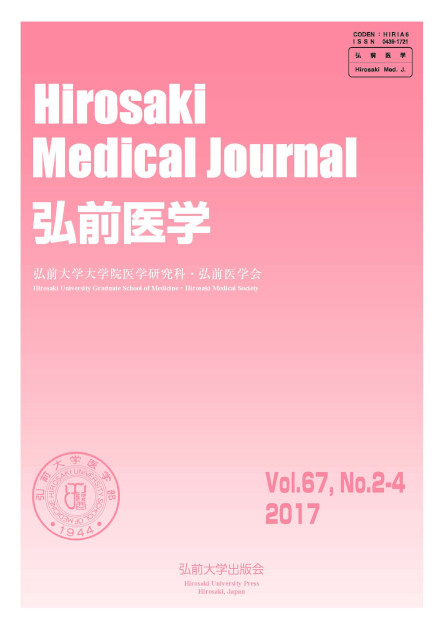Volume 67, Issue 2-4
Displaying 1-21 of 21 articles from this issue
- |<
- <
- 1
- >
- >|
Review
-
2017 Volume 67 Issue 2-4 Pages 115-128
Published: 2017
Released on J-STAGE: May 15, 2021
Download PDF (1693K)
Original Article
-
2017 Volume 67 Issue 2-4 Pages 129-135
Published: 2017
Released on J-STAGE: May 15, 2021
Download PDF (638K) -
2017 Volume 67 Issue 2-4 Pages 136-146
Published: 2017
Released on J-STAGE: May 15, 2021
Download PDF (1096K) -
2017 Volume 67 Issue 2-4 Pages 147-152
Published: 2017
Released on J-STAGE: May 15, 2021
Download PDF (1341K) -
2017 Volume 67 Issue 2-4 Pages 153-157
Published: 2017
Released on J-STAGE: May 15, 2021
Download PDF (648K) -
2017 Volume 67 Issue 2-4 Pages 158-165
Published: 2017
Released on J-STAGE: May 15, 2021
Download PDF (818K) -
2017 Volume 67 Issue 2-4 Pages 166-178
Published: 2017
Released on J-STAGE: May 15, 2021
Download PDF (1260K)
Abstracts of Meeting of Hirosaki Medical Society
-
2017 Volume 67 Issue 2-4 Pages 179-181
Published: 2017
Released on J-STAGE: May 15, 2021
Download PDF (1249K) -
2017 Volume 67 Issue 2-4 Pages 182-183
Published: 2017
Released on J-STAGE: May 15, 2021
Download PDF (865K) -
2017 Volume 67 Issue 2-4 Pages 184-
Published: 2017
Released on J-STAGE: May 15, 2021
Download PDF (789K) -
2017 Volume 67 Issue 2-4 Pages 185-
Published: 2017
Released on J-STAGE: May 15, 2021
Download PDF (626K) -
2017 Volume 67 Issue 2-4 Pages 185-
Published: 2017
Released on J-STAGE: May 15, 2021
Download PDF (677K) -
2017 Volume 67 Issue 2-4 Pages 185-
Published: 2017
Released on J-STAGE: May 15, 2021
Download PDF (645K) -
2017 Volume 67 Issue 2-4 Pages 185-
Published: 2017
Released on J-STAGE: May 15, 2021
Download PDF (642K) -
2017 Volume 67 Issue 2-4 Pages 186-
Published: 2017
Released on J-STAGE: May 15, 2021
Download PDF (590K) -
2017 Volume 67 Issue 2-4 Pages 186-
Published: 2017
Released on J-STAGE: May 15, 2021
Download PDF (588K) -
2017 Volume 67 Issue 2-4 Pages 186-
Published: 2017
Released on J-STAGE: May 15, 2021
Download PDF (570K) -
2017 Volume 67 Issue 2-4 Pages 186-
Published: 2017
Released on J-STAGE: May 15, 2021
Download PDF (631K) -
2017 Volume 67 Issue 2-4 Pages 187-
Published: 2017
Released on J-STAGE: May 15, 2021
Download PDF (591K) -
2017 Volume 67 Issue 2-4 Pages 187-
Published: 2017
Released on J-STAGE: May 15, 2021
Download PDF (567K) -
2017 Volume 67 Issue 2-4 Pages 187-
Published: 2017
Released on J-STAGE: May 15, 2021
Download PDF (646K)
- |<
- <
- 1
- >
- >|
